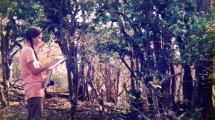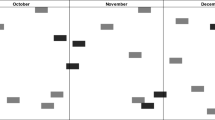Abstract
The antecedents and consequences of a change in status in the female line have been documented in the course of an ongoing study of a captive colony ofMacaca fascicularis. A conjunction of two events appears to have been a cause of the timing. The first is the maturation of the eldest female offspring of the subordinate lineage, and the second the insertion of an intrauterine device into the mother of that lineage. These changes made these two females simultaneously sexual associates of the adult male, while the dominant female of the other lineage was still pregnant. In the course of these events the maturing sub-adult female of the subordinate lineage underwent the most dramatic change of status, eventually rising from the lowest position to that of alpha female. The complex changes which heralded this alternation in status are described in terms of the referent relations and alliances which were evolving in the group.
Similar content being viewed by others
References
Angst, W., 1974. Das Ausdrucksverhalten des Javaneraffen,Macaca fascicularis Raffles.Adv. Ethol., 15: 5–90.
————, 1975. Basic data and concepts on the social organisation ofMacaca fascicularis. In:Primate Behavior: Developments in Field and Laboratory Research, Vol. V,L. A. Rosenblum (ed.), Academic Press, New York.
Bernstein, I. S., 1969. Spontaneous reorganisation of a pig-tailed monkey group.Proc. 2nd Int. Congr. Primat., 1: 48–51.
Brown, J. L., 1975.The Evolution of Behaviour. W. W. Norton & Co., Inc., New York.
Chance, M. R. A., 1956. Social structure of a colony ofMacaca mulatta.Brit. J. Anim. Beh., 4: 1–13.
————, 1976. Attention structure as the basis of primate rank order. In:The Social Structure of Attention,M. R. A. Chance &R. R. Larsen (eds.), Wiley, London, pp. 1–11.
————,E. Jones, &T. K. Pitcairn, 1974. Design of a cage for breeding and group behavioural studies ofMacaca fascicularis.Lab. Anim., 8: 13–19.
----, ----, &S. Shostak, in prep. Factors affecting nursing inMacaca fascicularis.
Fittinghoff, N. A., Jr., 1975. Riverine refuging in East BorneanMacaca fascicularis. Paper presented at meeting of the Amer. Ass. Phys. Anthrop’s, Denver, Colorado.
Hill, W. C. O., 1972.Evolutionary Biology of the Primates. Academic Press, London.
Jones, E., in prep. Social structure of a captive group of long-tailed macaques. Unpublished Ph. D. thesis, Univ. of Birmingham.
Kawai, M., 1965. On the system of social ranks in a natural troop of Japanese monkeys. (1) Basic rank and dependent rank. In:Japanese Monkeys,S. A. Altmann (ed.), pp. 66–86.
Kummer, H., 1968.Social Organisation of Hamadryas Baboons: A Field Study. Biblio. Primat., Vol. 6, 189 pp.
Kurland, J. A., 1973. A natural history of Kra macaques (Macaca fascicularis Raffles, 1821) at the Kutail Reserve, Kalimantan Timor, Indonesia.Primates, 14: 245–262.
Napier, J. R. &P. H. Napier, 1967.A Handbook of Living Primates. Academic Press, London.
Nash, L. T., 1974. Parturition in a feral baboon (Papio anubis).Primates, 15: 279–285.
Owens, N. W., 1975. A comparison of aggressive play and aggression in free-living baboons,Papio anubis.Anim. Behav., 23: 757–765.
Pitcairn, T. K., 1975. The structure of attention and social behaviour in two groups ofMacaca fascicularis. Unpublished M. Sc. thesis, Univ. of Birmingham.
————, 1976. Attention and social structure inMacaca fascicularis. In:Social Struction of Attention,M. R. A. Chance &R. R. Larsen (eds.), Wiley, London, pp. 51–83.
Poirier, F. E. &E. O. Smith, 1974. The crab-eating macaques (Macaca fascicularis) of Angaur Island, Palau, Micronesia.Folia primat., 22: 258–306.
Shirek-Ellefson, J., 1967. Visual communication inMacaca irus. Unpublished Ph. D. thesis, Univ. of California, Berkeley.
————, 1972. Social communication in some Old World monkeys and gibbons. In:Primate Patterns,P. Dolhinow (ed.), Holt, Rinehart & Winston, Inc., New York, pp. 297–311.
Van Hooff, J. A. R. A. M., 1967. The facial display of the catarrhine monkeys and apes. In:Primate Ethology,D. M. Morris (ed.), Weidenfeld & Nicolson, London, pp. 7–68.
Wickler, W., 1967. Socio-sexual signals and their intra-specific imitation among primates. In:Primate Ethology,D. Morris (ed.), Weidenfeld & Nicolson, London, pp. 69–147.
Yamada, M., 1971. Five natural troops of Japanese monkeys on Shodoshima Island: II. A comparison of social structure.Primates, 12: 125–150.
Author information
Authors and Affiliations
Additional information
The word “revolution” is reserved for a change in the type of social structure brough about by insurrection: rebellion occurs when insurrection changes the position of the individuals in a structure which is itself left unchanged -vide, Webster’s English Dictionary.
About this article
Cite this article
Chance, M.R.A., Emory, G.R. & Payne, R.G. Status referents in long-tailed macaques (Macaca fascicularis): Precursors and effects of a female rebellion. Primates 18, 611–632 (1977). https://doi.org/10.1007/BF02383139
Received:
Accepted:
Issue Date:
DOI: https://doi.org/10.1007/BF02383139




